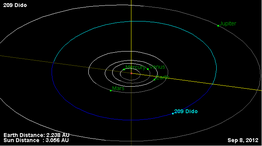209 Dido
Dido (minor planet designation: 209 Dido) is a very large main-belt asteroid. It is classified as a C-type asteroid and is probably composed of carbonaceous materials. Like many asteroids of its type, it has an extremely low albedo.
 | |
| Discovery | |
|---|---|
| Discovered by | C. H. F. Peters |
| Discovery date | 22 October 1879 |
| Designations | |
| (209) Dido | |
| Pronunciation | /ˈdaɪdoʊ/[1] |
Named after | Dido |
| A909 AB, A909 GB, A912 RB | |
| Main belt | |
| Adjectives | Didonian /daɪˈdoʊniən/[2][3] |
| Orbital characteristics[4] | |
| Epoch 31 July 2016 (JD 2457600.5) | |
| Uncertainty parameter 0 | |
| Observation arc | 136.47 yr (49845 d) |
| Aphelion | 3.33106 AU (498.319 Gm) |
| Perihelion | 2.96843 AU (444.071 Gm) |
| 3.14974 AU (471.194 Gm) | |
| Eccentricity | 0.057565 |
| 5.59 yr (2041.8 d) | |
Average orbital speed | 16.79 km/s |
| 311.722° | |
| 0° 10m 34.738s / day | |
| Inclination | 7.17313° |
| 0.682681° | |
| 248.387° | |
| Physical characteristics | |
| Dimensions | 159.94±3.1 km[4] 140.35 ± 10.12 km[5] |
| Mass | (4.59 ± 7.42) × 1018 kg[5] |
| 5.7366 h (0.23903 d)[4][6] | |
| 0.0349±0.001 | |
| C | |
| 8.24 | |
It was discovered by C. H. F. Peters on October 22, 1879, in Clinton, New York and was named after the mythical Carthaginian queen Dido.
Photometric observations at the Palmer Divide Observatory during 2005 showed a rotation period of 5.7366 ± 0.0005 hours with a brightness variation of 0.17 ± 0.02 in magnitude.[6]
References
- Noah Webster (1884) A Practical Dictionary of the English Language
- "didonia". Oxford English Dictionary (3rd ed.). Oxford University Press. September 2005. (Subscription or UK public library membership required.)
- Richard Shoaf (1983) Dante, Chaucer, and the currency of the word, p. 52 ff.
- "209 Dido". JPL Small-Body Database. NASA/Jet Propulsion Laboratory. Retrieved 12 May 2016.
- Carry, B. (December 2012), "Density of asteroids", Planetary and Space Science, 73, pp. 98–118, arXiv:1203.4336, Bibcode:2012P&SS...73...98C, doi:10.1016/j.pss.2012.03.009. See Table 1.
- Warner, Brian D. (December 2005), "Asteroid lightcurve analysis at the Palmer Divide Observatory - spring 2005", The Minor Planet Bulletin, 32 (4): 90–92, Bibcode:2005MPBu...32...90W.
External links
- Lightcurve plot of 209 Dido, Palmer Divide Observatory, B. D. Warner (2005)
- Asteroid Lightcurve Database (LCDB), query form (info)
- Dictionary of Minor Planet Names, Google books
- Asteroids and comets rotation curves, CdR – Observatoire de Genève, Raoul Behrend
- Discovery Circumstances: Numbered Minor Planets (1)-(5000) – Minor Planet Center
- 209 Dido at AstDyS-2, Asteroids—Dynamic Site
- 209 Dido at the JPL Small-Body Database

This article is issued from Wikipedia. The text is licensed under Creative Commons - Attribution - Sharealike. Additional terms may apply for the media files.